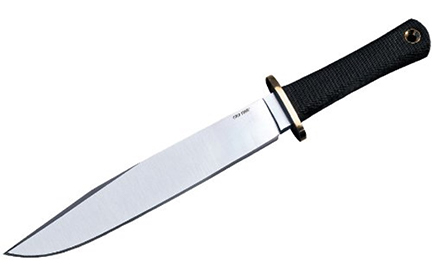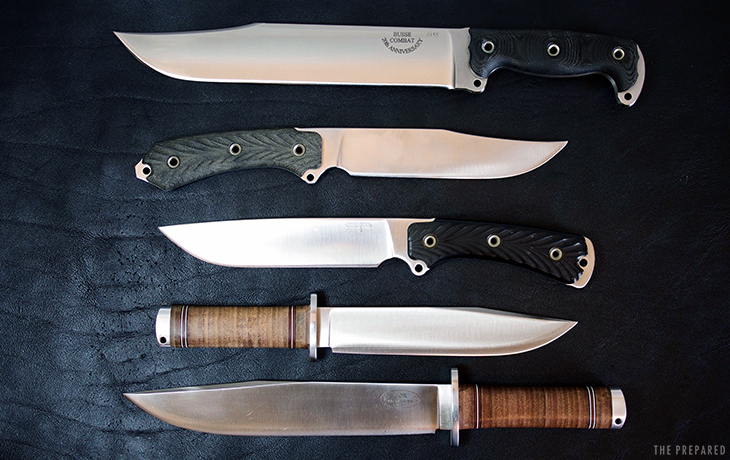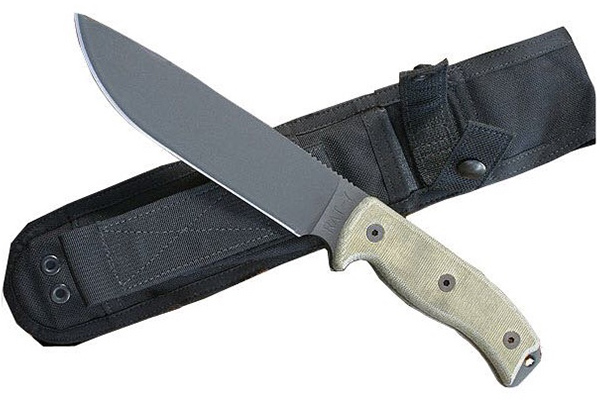The Bowie knife of the American South, the Saxon seax, the Japanese tanto, the Sami leuku — many world cultures have a signature “big knife” that’s used for fighting and light chopping.
We recommend most people stick with blades under 5.5 inches for their versatile do-everything blade — the criteria used in our best survival knife review — because large knives tend to be unwieldy, are less capable at survival tasks than a smaller knife + bigger hatchet/saw combo, and are primarily meant for fighting.
But some preppers have a personal preference for large knives. That’s fine, as long as you’re experienced and understand the choice. Check out this guide to mixing and matching various bladed tools if you’re not already sure that you want a big fighting knife.

Best for most people:
USMC KA-BAR

Bushcraft classic:
Ontario RAT7

Great value:
Schrade SCHF3N

Traditional fighter:
Cold Steel Trailmaster

Best in class:
Spartan Horkos
Be prepared. Don’t be a victim.
Want more great content and giveaways? Sign up for The Prepared’s free newsletter and get the best prepping content straight to your inbox. 1-2 emails a month, 0% spam.
The competition
We’ve reviewed, researched, and handled hundreds of knives over the past six years, and we consider the following 23 knives to be the best big tactical knives out there right now.
View the spreadsheet in Google Docs
What is a Bowie knife
Note: “Bowie” is pronounced “boo-ee”, and not “bow-ee” like the singer.
As common as the term “Bowie knife” is, you may be surprised to learn that there’s no clear definition of it that everyone agrees on. Jim Bowie’s original fighting knife is lost to history, probably looted from his corpse by an unnamed Mexican soldier at the battle of the Alamo. All that lives on of the original design are a few vague descriptions and a (very profitable) name.
Indeed, probably the best way to define this entire category of blades is: “a ‘Bowie knife’ is whatever a knife maker can sell to other people as a ‘Bowie knife’.”

Most modern Bowies are large fighting knives, usually well over 5 inches, that have a clip point of some kind. After that, though, things get fuzzy. The famous Bowie knife maker Bill Bagwell, an ABS Master Bladesmith, had a set of additional requirements for what he thought a Bowie knife should be — a curved rear false edge being the main criteria. But Bagwell was more of a booster of the idea of the Bowie and a purveyor of local Arkansas legend than he was a historian.
Opinions differ, so we return to our own working definition given above. If you bought a knife because it was advertised as a “Bowie,” then no matter how it looks or what it’s made of, it’s a Bowie.
Blade size: is bigger better?
Our general philosophy is that field knife blades should be under about 5.5 inches, because shorter blades work better for most camp chores and survival tasks. This approach is based on broad survivalist and modern military consensus, as well as the experience of our own experts.
However, with this “big knife” blade guide, we’re out of the realm of consensus and more in the realm of personal preferences and optimization for specific situations (wilderness survival, close quarters combat, hunting, etc.).
A few general guidelines you can use to help you think about big tactical knife blade sizes:
- Bigger (7” or over) is better for chopping, prying, or digging
- Smaller (under 6”) is better for carving, slicing, game and food preparation, and pretty much everything else you do with a knife that isn’t chopping, prying, or digging.
- For killing (fighting and hunting), bigger and smaller each have their own tradeoffs. Smaller is more concealable and maneuverable in tight quarters, but bigger gives you more reach, force, and deadly blade edge.
- The 6-inch compromise blades can do a little of everything, but the only thing they do well is killing; they’re worse at everything else than a more suitable blade size.
As you think through the parameters above, and imagine how you might use a knife in a disaster scenario, you can see that it gets confusing really quickly. It’s tough to pick a clear winner for your own personal situation, much less a winner that will work for everybody in a disaster.
Finally, overall body size is a major factor, here. If you’re inching up on 7 feet tall, a 6-inch blade may well be a “medium-sized” field knife in your large hands. If you barely crack five feet, you might find blades above 4.5 inches impossible to use for anything but (mostly ineffective) chopping.
To sum up, there are no hard-and-fast rules in the world of big blades. There’s no 80/20 for us to give you on big knife blade sizes, because our 80/20 on this whole topic is to avoid the “one knife for everything” fantasy like the plague, and to carry multiple tools that can better cover a variety of use cases.
Best for most: USMC KA-BAR review
- Price: $$
- Specs: 7” blade, 12” overall, 1095 cro-van steel, stick tang, leather handle
- Pros: Lightweight, time-tested design, great reputation, tough
- Cons: Stacked leather handle is slippery when wet and requires care
Who should buy this: The $70 USMC KA-BAR is great for preppers who want an affordable fighting and general utility knife that has been fully tested and proven over decades of field use. More specifically, if you need a large knife for a bug out or get home bag, and you can’t spend a lot of time field testing your choice to see if it really “clicks” with you, then the fact that this knife has clicked with generations of soldiers and outdoors people makes it a much safer bet than a newer, less widely accepted design.
Benefits: KA-BAR knows what they’re doing with the 1095 cro-van steel, and with their heat treatment it’s ultra tough and holds an edge well. Indeed, many preppers get this knife as a gift and then go out and beat on it because they didn’t pay for it, which is when they learn that it performs better than the high-dollar knife they really saved up for.
The stacked leather handle is light and comfortable, and the flat metal pommel can be used as a hammer.
The KA-BAR is lightweight for its size, and the blade shape is a classic fighter Bowie design that can stab and slice with the best of them.
Downsides: The stacked leather handle gets slippery when wet, and if it isn’t kept clean and dry it can rot with time.
This is not a full-tang blade, but rather a “stick tang” design, which is weaker than full-tang for things like prying and batoning.
The metal guard on the KA-BAR is great for keeping your hand off the blade when stabbing, but if you want to put your thumb over the spine for more control then it does get in the way. Some users will file the back part of the guard off with a Dremel, for this reason.
Even though this is a longer blade at 7 inches, it’s not as much of a chopper as most of the other knives this size. The KA-BAR is weighted more toward the handle, and blade even has scallops cut out of the sides that are there specifically to reduce weight. The upside is a very fast, maneuverable fighting blade, but the downside is poor chopping ability.
Also great: Ontario RAT 7
- Price: $$
- Specs: 7” blade, 12” overall, 1095 steel, full tang, Micarta handle
- Pros: Great reputation, tough, good chopper, very popular
- Cons: Few users are happy with the sheath
Who should buy this: The $65 Ontario RAT7 is for preppers who want a more bushcraft-oriented big knife, one that’s optimized more for wood processing and camp chores than for fighting.
Benefits: The RAT7’s drop point tip is strong enough to stab and dig with, and will penetrate deeply into material.
The blade uses a standard 1095 carbon steel, which is well tested and has an excellent heat treatment. The black powder coating helps with rust resistance and is durable, but don’t count on it to stand up to infinite abuse.
The canvas micarta handle provides excellent grip, and the jimping on the spine is aggressive enough but not overdone.
The balance on this blade is excellent, and overall the design works so well that when Randall Adventure Training (RAT) ended its knife-making collaboration with Ontario and turned itself into ESEE, it kept essentially the same design in the form of the nearly identical (but shorter and more expensive) ESEE 6.
Thanks to its grind and weight distribution, this blade is a great chopper. So it’s great for cutting and limbing small trees and branches, and for batoning.
Downsides: The main downside to the RAT7 is the sheath. Many customers report that these thin, cordura sheaths feel flimsy and cheap. So if you go with this knife, plan to factor in another $10 to $40 for either a standard leather knife sheath, or a Kydex sheath.
Because the RAT7 is so popular and the sheath is so bad, there is a rich online aftermarket for RAT7 sheaths. KA-BAR leather sheaths are also reported to work well, and are inexpensive.
Note: We’ve selected the RAT7 without serrations, which we think you should avoid in knives meant for field use.
Budget choice: Schrade SCHF3N
- Price: $
- Specs: 6.4” blade, 12” overall, 8Cr13MoV steel, full tang, Micarta handle
- Pros: Tough, inexpensive, great design, very popular
- Cons: Hollow ground blade gives up some toughness and chopping ability
Who should buy this: The $45 Schrade SCHF3N is for preppers who want the design, materials, and performance of a serious, hard-use tactical fixed blade in an under-$50 package. If the KA-BAR didn’t have the advantage of decades of tradition and testing behind it, the SCHF3N would probably be our top pick overall for preppers who just want a “big knife” to stash in their emergency kit, because it’s such an incredible value.
Benefits: The full-tang blade is made of 8Cr13MoV, a Chinese stainless that’s extremely tough and easy to sharpen. This is a stainless blade that you can really beat on and expect it to hold up.
The canvas Micarta handle slabs are a feature that you’d normally find on a knife twice the price of the SCHF3N, and they combine with the great steel and excellent design to give the impression of a knife that should cost at least twice as much.
This knife’s edge grind makes it a keen slicer that bites deeply into materials like wood and flesh. It will also carve well.
Downsides: The SCHF3N’s blade is hollow ground, which we’re not a fan of on knives meant for hard field use. A hollow grind is cheaper to put on mass-produced blades, but it’s also weaker and worse at chopping than most other grinds.
Note: We chose the non-serrated version of this knife.
Brand and product reputation: Up until recently, the Schrade brand has not been very well regarded in knife circles. The much older Schrade knives of the 80’s and 90’s were good, but the quality declined drastically after that and has only recently begun to recover. The SCHF3N is one of a batch of outdoors knives that have resurrected the brand in recent years, garnering rave reviews in forums, YouTube, and across the web.
Best large Bowie knife: Cold Steel Trailmaster in O1 steel
- Price: $$$
- Specs: 9.5” blade, 14.5” overall, O1 steel, Kraton handle
- Pros: Tough, well-balanced, fit and finish are outstanding, great chopper, traditional design
- Cons: This knife is really large, which presents challenges for carry and concealment
Who should buy this: The $120 Cold Steel Trailmaster in O1 steel is the top choice for people who want a hand-to-hand weapon that lets them go the full “Jim Bowie.” This award-winning design is great for fighting bad guys and stabbing wild hogs, and can be pressed into service as a wood processing tool in the bush. So buy this if you want a traditional, uniquely American weapon that you can also chop with.
Benefits: The Trailmaster is a classic Bowie pattern, from the long, slender blade down to the handle that gives a slight nod to the Bowie knife’s traditional “coffin” shape. It’s optimized for killing, but has enough blade thickness to make short work of moderate-sized branches and trees.
The guard will keep your hand from sliding onto the blade as you stab, and the Kraton handle provides ample grip.
You can get the Trailmaster in cheaper SK5 steel, but we recommend sticking with the superior O1 — for a knife this big, you want a steel that’s as tough as possible, and O1 is very tough. You can also get this knife in a laminated stainless variant, but unless you live near salt water you’re better off with the tougher, high-carbon O1 steel.
Downsides: The Trailmaster is big and expensive, and the round guard will limit your carry and concealment options (the guard bulges out to the sides).
Brand and product reputation: The Cold Steel name has gone up and down with knife nuts over the years, and lately it’s probably more down than up. But the Trailmaster itself remains a flagship product and a standout in the company’s lineup. Reviewers love it, and there are few reports of problems.
Best upgrade: Spartan Horkos
- Price: $$$$
- Specs: 5.7” blade, 11” overall, S35VN steel, full tang, Micarta handle
- Pros: Sterling pedigree and design, super tough stainless steel, best in class performance
- Cons: Expensive
Who should buy this: The $360 Spartan Horkos is for preppers who want a deadly edged weapon designed by modern warfighters for modern warfighters — the fully modern answer to the USMC KA-BAR. The Horkos also makes a great, relatively slim and compact general-purpose field knife, but its primary function is killing things.
Benefits: The Horkos was designed in collaboration with the Combat Weapons Team at West Point, and one of these knives is presented to each graduate of that elite class.
The design is compact and concealable for its size, but extremely effective in close quarters.
The S35VN blade steel is one of the best stainless super steels on the market for big knives, and it combines excellent corrosion resistance with toughness and edge retention.
The blade’s harpoon tip has a lot of metal behind it, so you get tip strength in addition to deep penetration when stabbing, digging, and drilling.
The large finger choil lets you choke up on the edge for fine work, and the handle beneath the choil is sculpted just enough to prevent your hand from slipping up on the blade during stabbing.
Downsides: The price is the main downside to this blade. The fact that it uses a stainless, S35VN, and not a high-carbon steel, could also be considered a downside by some, but we’ve seen no reports of chipping or breaking with the Horkos.
Brand and product reputation: The tactical knife scene has been overly crowded for at least 20 years, so it’s a minor miracle that Spartan Blades has risen to the top of it since their launch in 2008. This small shop has been racking up awards and elite military contracts since the second year of its existence, and the Horkos is one of the flagship models that the company’s reputation rests on.





